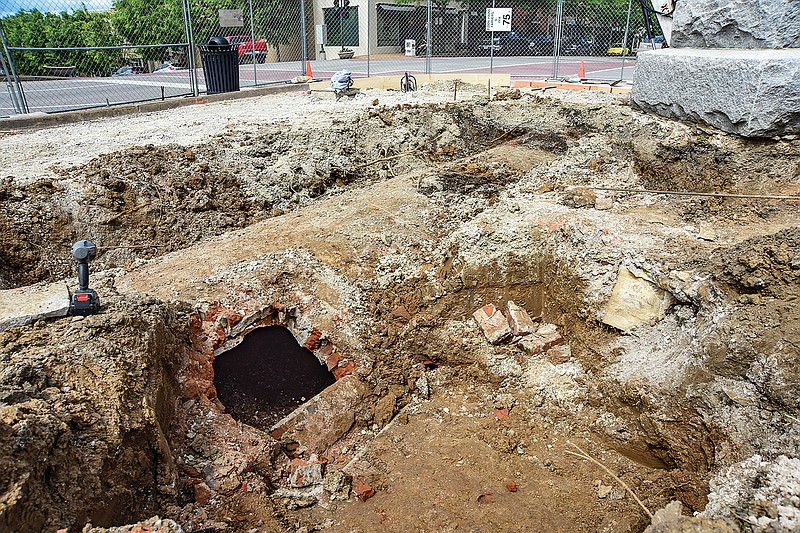Paris and Naples have their catacombs, London has its abandoned tube stations and Jefferson City, too, has history beneath its streets.
In early May, work crews digging in the lawn of the Cole County Courthouse were surprised to discover brick-lined underground tunnels. Neither city engineers, Cole County nor Ameren officials were aware of their existence.
Why and when were they built? What are the secrets of these shadowy recesses? Our imaginations can probably conjure a far more intriguing answer than reality.
Area businessman Michael Deetz had the opportunity to peer into the murky depths of the recently uncovered courthouse tunnel. He observed the tunnels were about 2 feet below the surface, about 6 feet wide, had arched brick-lined ceilings (in good shape) and dirt floors (maybe). The height varied because silt, dirt and debris had fallen, raising the base.
It did not appear to run under High Street, but parallel to it. Although he did not foray into the darkness far, Deetz saw no artifacts revealing its former use. (And no skeletons or rats the size of dogs, as legends go.)
A clue is offered in the biographical sketch of Swedish immigrant Ernst Simonsen. A mechanical engineer, Simonsen came to America in 1881, then to Jefferson City in 1889 along with a colleague, Henry Walther. They bought the Jefferson Foundry, located in what is now Jefferson Landing, and renamed it the Simonsen-Walther Manufacturing Company.
In 1895, Simonsen teamed up with P. H. Loethen to create the Jefferson Heating Company and soon after sold his interest in the foundry. The heating company offered the relatively new district heating technology that was sweeping the nation - one central source of heat to supply a network of buildings through underground pipes.
First introduced in the United States in the 1870s, it was a steam-based convection heating system fueled by coal. The heating company's power plant, heated water to create steam. Propelled by turbines, the steam moved through a network of pipes housed in underground tunnels big enough for a man to walk in.
The steam was delivered to the building, distributing heat through radiators. As the steam cooled and re-condensed into water, it was moved back to the power plant in a circuit to be reheated. Steam leaving the power plant could reach temperatures of 90-95 degrees Fahrenheit. The water returning to the plant was around 65-70 degrees Fahrenheit.
It is the same science used in a home basement boiler but on a larger scale. The company also sold on-site boilers.
District heating systems were in wide use up to the 1930s. The old Missouri State Penitentiary used such a system, as did many university campuses, and many still do. There are many tales of attempted prisoner escapes through these tunnels and of adventurous students exploring campus tunnels.
In Simonsen's biography in the 1900 Cole County Sketch Book, some of the buildings served by his company were noted, including the "Cole County Courthouse, Gasconade County Courthouse, four buildings at Lincoln Institute, Missouri Pacific Passenger Station, State Armory, Exchange Bank, Dallmeyer Building, Realty Building and a number of private residences." The Armory in 1900 was on the Capitol grounds facing Broadway.
The fact his heating company served the courthouse is the evidence the tunnels uncovered are likely cavities of steam tunnels. One question that begs to be answered: Who built these tunnels?
Due to failing health, Simonsen sold his interest in the heating company in 1910. But it is reasonable to assume his service expanded to other buildings after 1900.
We remember Simonsen not for his heating company but for the public school named after him. In 1903, he married Fredericka DeWyl, Missouri's first registered female pharmacist. Simonsen was active in the community, with particular interest in the city's education system, and had plans to monetarily assist the local schools. But when he died in 1913, it was Fredericka who faithfully fulfilled her husband's dream. It was noted in a Daily Capitol News article in 1943, "His was the first automobile funeral conducted in the city,"
The high school in the 500 block of East Miller Street was completed in 1905, but it lacked funds to equip "manual training and domestic science departments," the article noted. Fredericka made these funds available in her husband's name. "This was one of the largest gifts ever made to a public school in Missouri" at the time.
Simonsen's tunnels seem to be a few of many tunnels under Jefferson City that tease our fascination. The brewing company on the Southside had tunnels. Some old houses in town reportedly had tunnels to the river. Some houses had tunnels to keep things cool or to hide illegal liquor or runaway slaves. The courthouse tunnels are now buried under a concrete pad, but whatever their purpose, we are drawn to their mystery and intrigue.
Jenny Smith is a retired chemist with the Highway Patrol Crime Lab and former editor of the Historic City of Jefferson's Yesterday and Today newsletter.

